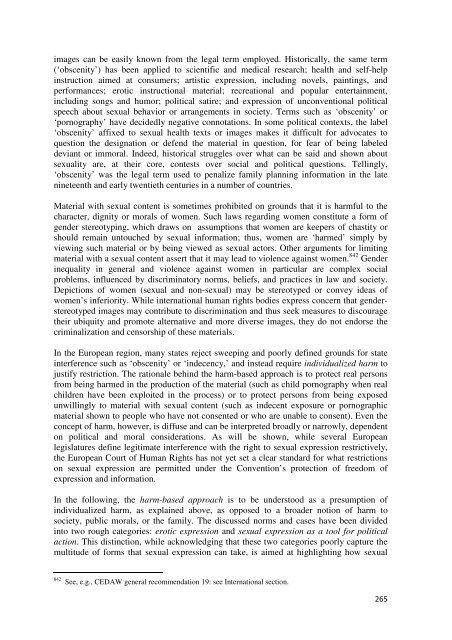Johanna Westeson - The ICHRP
Johanna Westeson - The ICHRP
Johanna Westeson - The ICHRP
You also want an ePaper? Increase the reach of your titles
YUMPU automatically turns print PDFs into web optimized ePapers that Google loves.
images can be easily known from the legal term employed. Historically, the same term<br />
(‘obscenity’) has been applied to scientific and medical research; health and self-help<br />
instruction aimed at consumers; artistic expression, including novels, paintings, and<br />
performances; erotic instructional material; recreational and popular entertainment,<br />
including songs and humor; political satire; and expression of unconventional political<br />
speech about sexual behavior or arrangements in society. Terms such as ‘obscenity’ or<br />
‘pornography’ have decidedly negative connotations. In some political contexts, the label<br />
‘obscenity’ affixed to sexual health texts or images makes it difficult for advocates to<br />
question the designation or defend the material in question, for fear of being labeled<br />
deviant or immoral. Indeed, historical struggles over what can be said and shown about<br />
sexuality are, at their core, contests over social and political questions. Tellingly,<br />
‘obscenity’ was the legal term used to penalize family planning information in the late<br />
nineteenth and early twentieth centuries in a number of countries.<br />
Material with sexual content is sometimes prohibited on grounds that it is harmful to the<br />
character, dignity or morals of women. Such laws regarding women constitute a form of<br />
gender stereotyping, which draws on assumptions that women are keepers of chastity or<br />
should remain untouched by sexual information; thus, women are ‘harmed’ simply by<br />
viewing such material or by being viewed as sexual actors. Other arguments for limiting<br />
material with a sexual content assert that it may lead to violence against women. 842 Gender<br />
inequality in general and violence against women in particular are complex social<br />
problems, influenced by discriminatory norms, beliefs, and practices in law and society.<br />
Depictions of women (sexual and non-sexual) may be stereotyped or convey ideas of<br />
women’s inferiority. While international human rights bodies express concern that genderstereotyped<br />
images may contribute to discrimination and thus seek measures to discourage<br />
their ubiquity and promote alternative and more diverse images, they do not endorse the<br />
criminalization and censorship of these materials.<br />
In the European region, many states reject sweeping and poorly defined grounds for state<br />
interference such as ‘obscenity’ or ‘indecency,’ and instead require individualized harm to<br />
justify restriction. <strong>The</strong> rationale behind the harm-based approach is to protect real persons<br />
from being harmed in the production of the material (such as child pornography when real<br />
children have been exploited in the process) or to protect persons from being exposed<br />
unwillingly to material with sexual content (such as indecent exposure or pornographic<br />
material shown to people who have not consented or who are unable to consent). Even the<br />
concept of harm, however, is diffuse and can be interpreted broadly or narrowly, dependent<br />
on political and moral considerations. As will be shown, while several European<br />
legislatures define legitimate interference with the right to sexual expression restrictively,<br />
the European Court of Human Rights has not yet set a clear standard for what restrictions<br />
on sexual expression are permitted under the Convention’s protection of freedom of<br />
expression and information.<br />
In the following, the harm-based approach is to be understood as a presumption of<br />
individualized harm, as explained above, as opposed to a broader notion of harm to<br />
society, public morals, or the family. <strong>The</strong> discussed norms and cases have been divided<br />
into two rough categories: erotic expression and sexual expression as a tool for political<br />
action. This distinction, while acknowledging that these two categories poorly capture the<br />
multitude of forms that sexual expression can take, is aimed at highlighting how sexual<br />
842 See, e.g., CEDAW general recommendation 19: see International section.<br />
265
















